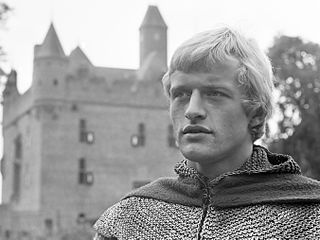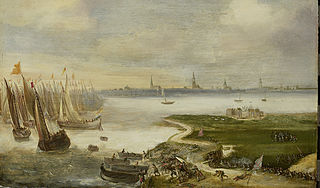
Abraham Ortelius was a Brabantian cartographer, geographer, and cosmographer. He is recognized as the creator of the first modern atlas, the Theatrum Orbis Terrarum. Along with Gemma Frisius and Gerardus Mercator, Ortelius is generally considered one of the founders of the Netherlandish school of cartography and geography. He was a notable figure of this school in its golden age and an important geographer of Spain during the age of discovery. The publication of his atlas in 1570 is often considered as the official beginning of the Golden Age of Netherlandish cartography. He was the first person proposing that the continents were joined before drifting to their present positions.

Floris is a 1969 Dutch action television series starring Rutger Hauer and Jos Bergman, written by Gerard Soeteman, and directed by Paul Verhoeven.

The Royal Library of the Netherlands is the national library of the Netherlands, based in The Hague, founded in 1798. The KB collects everything that is published in and concerning the Netherlands, from medieval literature to today's publications. About 7 million publications are stored in the stockrooms, including books, newspapers, magazines and maps. The KB also offers many digital services, such as the national online Library, Delpher and The Memory. Since 2015, the KB has played a coordinating role for the network of the public library. The KB's collection of websites as hosted by the former Dutch internet provider XS4ALL is on the Unesco documentary world heritage memory of the world. It is the first web collection in the world that has been granted this status.

The United Belgian States, also known as the United States of Belgium, was a short-lived confederal republic in the Southern Netherlands established after the Brabant Revolution. It existed from January to December 1790 as part of the unsuccessful revolt against the Habsburg Emperor, Joseph II.
Richard Rowlands, born Richard Verstegan, was an Anglo-Dutch antiquary, publisher, humorist and translator.

Elzevir is the name of a family of Dutch booksellers, publishers, and printers of the 17th and early 18th centuries. The duodecimo series of "Elzevirs" became very famous and very desirable among bibliophiles, who sought to obtain the tallest and freshest copies of these tiny books.

Habsburg Netherlands was the Renaissance period fiefs in the Low Countries held by the Holy Roman Empire's House of Habsburg. The rule began in 1482, when the last Valois-Burgundy ruler of the Netherlands, Mary, wife of Maximilian I of Austria, died. Their grandson, Emperor Charles V, was born in the Habsburg Netherlands and made Brussels one of his capitals.
Nieuwe Tijdinghen is the contemporary name cataloguers and bibliographers have given to the first Flemish newspaper, which was published without a single fixed title. News was printed from across Western and Central Europe.
Rutger Velpius was a 16th- and 17th-century printer and bookseller. He was the first printer in the city of Mons, and later became printer to the court in Brussels. His career coincided closely with the first decades of the Dutch Revolt
The Gazette van Gent was a twice-weekly newspaper originally published in Ghent from 1723 to 1809 under the title Gazette van Ghendt. The publisher switched to French in 1809, first under the title Gazette de Gand and from 1811 as Journal du département de l'Escaut. Dutch-language publication resumed in 1814, initially under the title Gazette van Gend, and continued until 1940, with a hiatus during the First World War.

This is a timeline of Belgian history, including important legal and territorial changes and political events in Belgium and its predecessor states. To read about the background to these events, see History of Belgium. See also the list of Belgian monarchs.
The following is a timeline of the history of the municipality of Ghent, Belgium.
The Abraham Catalogue of Belgian Newspapers is an online database of historical Belgian newspapers that are preserved in libraries and other heritage institutions across Flanders and Brussels.

Don Íñigo de Borja y Velasco (1575–1622) was a Spanish nobleman and military commander who served as governor of Antwerp Citadel.
Events in the year 1851 in Belgium.

Charles Joseph Emmanuel van Hulthem (1764–1832) was a bibliophile from the Low Countries whose collection of books provided the first kernel of the Royal Library of Belgium.

Constant-Philippe Serrure (1805–1872) was a prolific Belgian historian and collector who taught at Ghent University. He was a founding member and active contributor of the Maetschappy der Vlaemsche Bibliophilen, which published editions of medieval Flemish texts.
Vlaamse Erfgoedbibliotheek or Flanders Heritage Library is a library consortium in the Flemish Region of Belgium bringing together six institutions with considerable holdings of manuscripts and old printed books. The network was founded in 2008, and was authorised as a heritage organisation for Flanders in 2012.
Nicolaes Breyghel, Latinized Nicolaus Breyghelius, was a leading printer and bookseller in 17th-century Bruges in the Habsburg Netherlands. He was the first publisher of a weekly newspaper in the city.
The Bruges Public Library is a public library in Bruges, Belgium.










